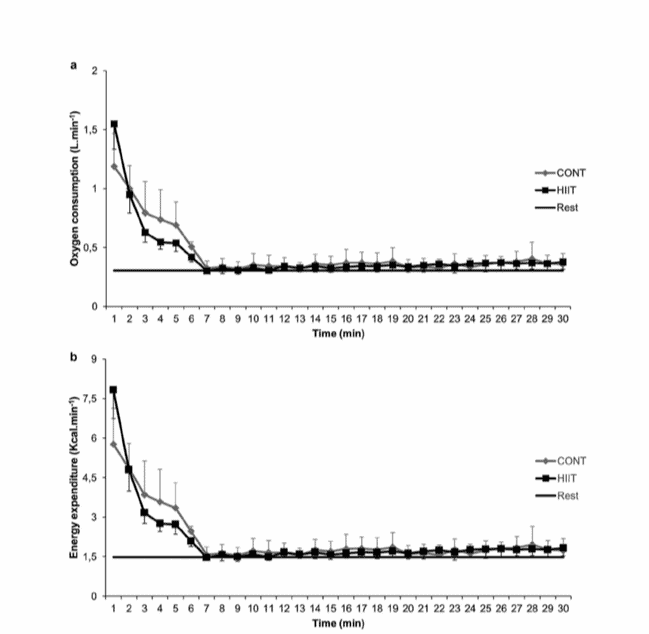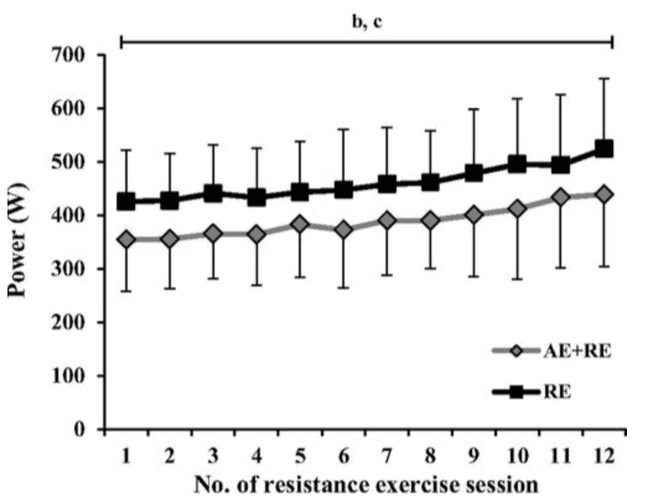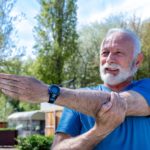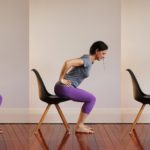
Kim Hoffmann
NASM CES (Corrective Exercise Specialist) and Certified Personal Trainer
In Weight Training for Fat Loss we explained what fat loss is and how the body uses calories. However, there is more to weight loss than simply calories in versus calories out. Specifics such as our
- sex
- age
- hormones
- stress levels
- sleeping habits
can make it easier or more difficult to lose weight. In this article we will continue focussing on the cardio part of fat loss.
Cardio training
Cardio training is any kind of training where we increase our heart rate, blood flow and make our heart and lungs work more efficiently.
It can refer to high intensity training, like boxing and HIIT sessions or low-intensity steady state (LISS), also known as endurance training, such as running and cycling.
The difference lies in the intensity and our goals. If we’re training to get fit, high intensities will suit us better, whereas if we’re training for a marathon or fat loss, as we’ll see later, long and slow is the way to go.
Although most people will see some fat loss during HIIT sessions as well.
What are the benefits of cardio training?
There are a number of benefits to cardio training:
- It strengthens our heart and blood vessels which helps reduce the risk of heart disease or problems with blood pressure or cholesterol
- It improves our mood and reduce stress while increasing our energy levels
- It burns calories which helps to maintain or lose weight
- It can help prevent or reduce the risk of stroke, depression and type 2 diabetes
RELATED — Depression Signs and Symptoms: Stop the downward spiral in time (Part 1)
Cardio helps our heart and lungs function better. This means that it becomes better at pumping blood and oxygen around our body. The lungs provide oxygen for energy and remove carbon dioxide. The heart pumps this oxygen to the muscles that are doing the exercise.
Because everything is working faster during a cardio session, we will get breathless. This is normal. Over time, however, our muscles will become stronger and thus more efficient which means that they will need less oxygen to move and they will produce less carbon dioxide. This means that we won’t need as much air to breathe in and out to do the same exercise.
When the heart becomes stronger and more efficient, the heart rate in general slows down. This tells us that the heart is functioning well and is less likely to have cardiac events.
Cardio training for fat loss
Cardio training can generally be done at different speeds and at different intensities.
In lower intensities our body uses oxygen (aerobic) to fuel the muscles. This happens when we move in everyday life and also when we train in heart rate zones 1 and 2
RELATED — Zone Training: What is it and what is it good for?
In short, different zones means different heart rates. Lower heart rates (zones 1-2/3) tend to burn fat. Higher heart rates (zones 4 and 5) burn glucose (from carbohydrates) to get energy for the exercise.
Lower heart rates (zones 1-2/3) tend to burn fat
By using fat as an energy source, we will be able to run/cycle/jog for longer than if we were to use carbohydrates.
Each heart rate zone has its benefits and functions. For fat loss it’s important to stay within the fat burning range. This means that we’ll be doing slow and steady cardio (LISS – Low-Intensity Steady State).
To know whether you’re going at the right speed for fat burning, you need to be able to carry a conversation, no matter the activity.
You could also use a heart rate monitor to track your heart rate and see whether you’re within the right zone(s).
What does a cardio session look like?
As mentioned there are two types of cardio sessions we can do, which are:
- HIIT training
- Low-Intensity Steady State (LISS)
Research suggests that the same amount of energy is burnt during both HIIT and LISS workouts and even afterwards, the effects of EPOC (Excess Post-Exercise Oxygen Consumption), or afterburn, are minimal.[1]

This graph shows how little difference there is in the afterburn between continuous exercise and HIIT.

As we can see from the graph above, continuous exercise had a greater total energy expenditure whereas HIIT had a higher EE per minute.
I would limit the amount of HIIT sessions to 2-3 times per week because of the amount of stress put on the body.
Limit HIIT sessions to 2-3 times per week
If we do want to incorporate HIIT sessions as part of our workout routine, we’ll need to do short bursts of very intense exercise and then rest.
The rest should be shorter than the work time. So if we work for 30 seconds, then we should rest for 10-20 seconds, but that depends on our fitness levels. You may want to start with a 1:1 ratio of 30 seconds work and 30 seconds rest.
For HIIT workouts it’s important to use full body exercises, like the dreaded burpees, mountain climbers, squat jumps, and others.
For HIIT workouts use full body exercises
We can also use free weights, such as dumbbells, kettlebells, battle ropes, or sand bags to make our body work harder.
Make sure that if you use weights and you’re new to exercise, you employ a trainer to learn the proper form. It’s very easy to injure yourself.
If you’re using a heart rate monitor of some sort, take care that you’re at 80% and above of your max heart rate.
A steady-state cardio workout can be done on any day as long as it’s not before a weight lifting workout or done too intensely every day (no more than 70% of your maximum heart rate).
If you’re very new to exercise or you’re significantly overweight, you could start with a walk or adding more movement throughout your day before trying to jog.
To start, warm up for a few minutes, where we stretch our muscles and warm up our joints, like swinging our legs forwards and backwards. We can also do some bodyweight squats or lunges.
Then we continue with a gentle jog, swim or cycle at our heart rate zone 2 for a few minutes, or until we fatigue. At the beginning that might be very soon, but the longer we stick with it, the longer we will be able to go.
Once we’ve reached our desired kilometres or time, we can finish with a cooldown. Some static stretching will do the job.
An important reason to choose LISS over HIIT is if you have an injury or condition that requires you to move at lower intensities or that is low impact.
Weight training vs cardio
Weight training builds muscle mass while cardio improves heart and lung function. It is a common misconception that cardio builds muscle.
We need to put our body under load in order to build muscle mass and cardio doesn’t do that, so a combination of the two is ideal.
It is important to note that cardio and weight lifting can interfere with each other’s results. That is because they require opposite adaptations from our muscles. It is important to be clear on our goal and go from there.
When doing resistance training our muscles will improve in strength, power and size, but will decrease in mitochondrial density which is important in aerobic activity.
On the other hand, LISS increases the oxidative capacity (how well our muscles can take up oxygen) but decreases power output and possibly decreases the size of Type 2 muscle fibres.
Cardio and weight lifting can interfere with each other’s results
Research seems to suggest that cardio before a strength session can counteract our progress during strength training (power) but if we’re working for muscle size (hypertrophy), doing cardio before resistance training is fine as long as we have at least 6 hours in between (Lundberg et al., 2014).[2]

When we do LISS, the body releases a protein called AMPK (adenosine monophosphate-activated protein kinase). AMPK regulates our body’s energy metabolism during exercise. It helps our body conserve energy and inhibit muscle building.
Muscle building demands a lot of energy and so this process should be suppressed when doing long distance exercise because we need to conserve this energy.
For women it’s even more important to have a combination of cardio and weight training because of the high risk of low bone density and osteoporosis, especially after menopause.
RELATED – Menopause and Weight Gain: Why do we put on weight during menopause?
While many seem to prefer steady state cardio, it is important to combine this with lifting heavy weights and HIIT.
This preference for LISS is in part due to having more type 1-slow twitch fibres in the muscles compared to men who have more type 2- fast twitch fibres. This makes women better at or, at least, prefer long distance, whereas men tend to lean towards the short and quick burst of activity, such as weight lifting or sprints.
While many seem to prefer steady state cardio, it is important to combine this with lifting heavy weights and HIIT.
This preference for LISS is in part due to having more type 1-slow twitch fibres in the muscles compared to men who have more type 2- fast twitch fibres. This makes women better at or, at least, prefer long distance, whereas men tend to lean towards the short and quick burst of activity, such as weight lifting or sprints.
Frequency
Frequency is difficult to determine, because it depends on how much time we have.
We might prefer slow steady state cardio, such as going for a 10k run or so, but we might not have time every day. In that case we could exchange a run for a 20-minute HIIT session.
In any case, for fat loss, we want to plan our weekly workouts consisting of weight training, steady-state cardio and maybe some HIIT. Please see the table below as an example.
Monday | Tuesday | Wednesday |
Weight training | Steady State | Rest |
Thursday | Friday | Saturday/Sunday |
Weight training | Steady State | Rest |
It could also look like this (if you’re more advanced):
Monday | Tuesday | Wednesday |
AM: Weight training PM: Steady State | AM: Weight Training PM: Steady State | HIIT |
Thursday | Friday | Saturday/Sunday |
AM: Weight training PM: Steady State | AM: Weight Training PM: Steady State | HIIT/Rest or vice versa |
If you’re new to cardio, you could start with 15-30 minutes, but over time you can increase that up to 60-90 minutes if time allows.
How much cardio is needed for fat loss?
That is a difficult question to answer because it relies on different factors, such as age, sex, diet, lifestyle and others. In general, the older we are, the harder it is to lose fat because our metabolism slows down.
But if you’re overweight or obese, it will be easier to lose fat because you have more of it and because the desired heart rate for fat loss will be reached sooner than compared to someone who is aerobically or anaerobically fit but slightly overweight.
Another thing is that diet is very hard to change for many people. We can workout every day of the week, but if we eat unhealthy foods, we will not see much of a difference.
In saying that, if we’re consistent with our training, regardless of what type of cardio we do, we will lose weight as long as we’re in a calorie deficit. There are several studies that show that no matter what exercise regime we choose, we will lose weight.[3]
But if you’re looking for more concrete information, the general recommendation is 250-300 minutes of moderate-intensity exercise per week (approximately 2000 kcal per week burned), which equates to 50 minutes 5 days per week.[4]
We can break this up into shorter sections throughout the day. Brisk walking is an example of moderate intensity.
Related Questions
1. Can I do steady state cardio 7 days a week?
Yes, but I wouldn’t recommend it.
The body will need rest at some point. Unless it’s a gentle walk or active recovery.
2. Can I do HIIT every day?
No, HIIT is not recommended to do every day.
This is because it puts too much stress on the body if done right, and when in prolonged stressful situations, the body tends to hold on to extra fat.
3. Can I split up my cardio throughout the day?
Yes, it’s important to move more throughout the day for general health reasons as well as fat loss, so whether you do your cardio at the end or in smaller bouts, either will work.
RELATED — Weight Training for Fat Loss
Kim Hoffmann is a certified Personal Trainer and Corrective Exercise Specialist based in Auckland. She also specialises in women’s health and fitness by taking into consideration the menstrual cycle and hormones and implementing them in different workout plans. The workout methods and routines include free weights, suspension straps and boxing, as well as strength training and high intensity…
If you would like to learn more about Kim, see Expert: Kim Hoffman.
References
(1) Schaun, G. Z., Alberton, C. L. & Pinto S. S. (2018) Energy expenditure and EPOC between water-based high-intensity interval training and moderate-intensity continuous training sessions in healthy women.
(2) Lundberg, T. R., Fernandez-Gonzalo, R. & Tesch, P. A. (2014). Exercise-induced AMPK activation does not interfere with muscle hypertrophy in response to resistance training in men. https://doi.org/10.1152/japplphysiol.01082.2013
(3) Yildiz, M. & Akyildiz, Z. (2017) The Effects of Interval Running Exercise on Acute Calorie Expenditure.
(4) Donnelly, J. E., Blair, S. N., Jakicic, J. M., Manore, M. M.,Rankin. J. D., & Smith, B. K. (2009) Appropriate Physical Activity Intervention Strategies for Weight Loss and Prevention of Weight Regain for Adults. Medicine & Science in Sports & Exercise 41(2):p 459-471. | DOI: 10.1249/MSS.0b013e3181949333






